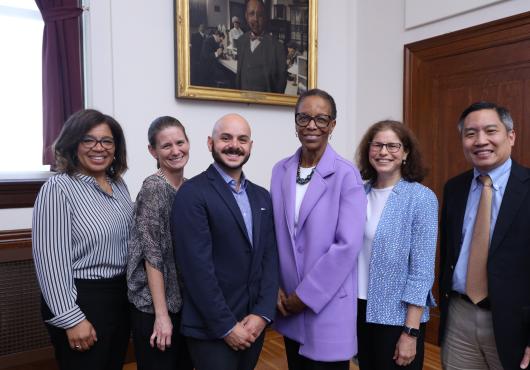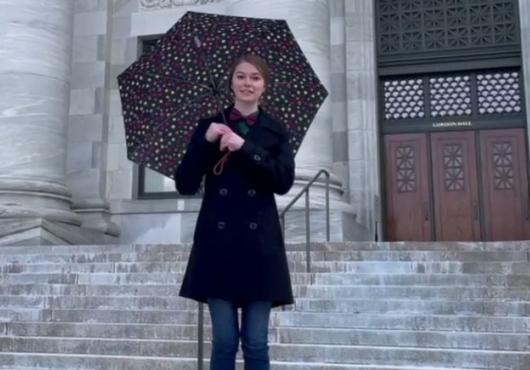
Against the backdrop of a mature tree with deep, spreading roots and a full canopy of multicolored leaves, a mural created by Castle Society student Ryoko Hamaguchi, the cast of the 17th annual Harvard Medical School FABRIC show closed the event by singing Michael Jackson’s “Heal the World.”
“Heal the world
Make it a better place
For you and for me
And the entire human race”
“As doctors, our goal in this life is to heal,” said Cannon Society student Jeffrey Taylor before fellow students performed the finale during Revisit weekend.
The first-year students produced a show for prospective members of the HMS/HSDM Class of 2021 that demonstrated the School’s commitment to diversity, unity and equity.
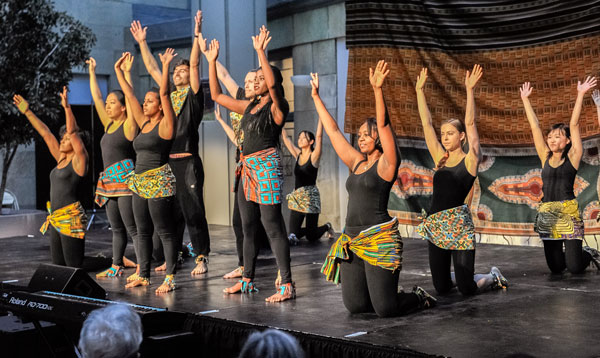
Current HMS and HSDM students showcased those inclusive values through song, dance, fashion and spoken-word performances on April 21 in the TMEC Atrium.
Returning to the origins of the FABRIC performances, the students chose “Gbongbo,” which means “root” in Yoruba, a language spoken principally in Nigeria, as the theme for this year’s show.
Beginnings
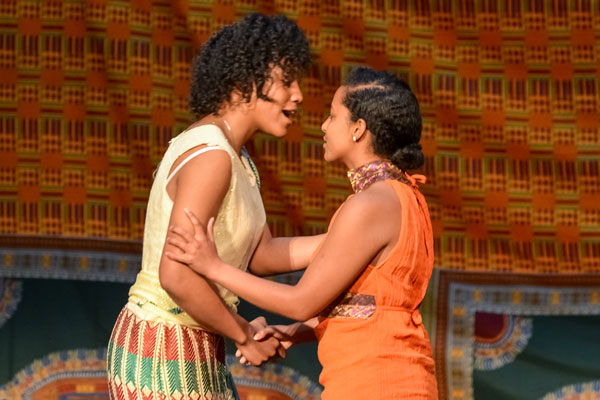
Conceived as way to recognize and honor the African diaspora, FABRIC, as its name suggests, was initially a fashion show. Over the years it branched out to include a variety of art forms and performances representing many cultures.
“FABRIC has become this vehicle with which we can share our values, all the while celebrating a culture that has given us all so much,” said Peabody student Troy Ameen as he introduced the African fashion show.
Roots
The fashion show began with light tapping on bongos that grew in tempo and intensity, concluding in a chant led by those on stage: “We’re going back to our roots, roots/What you know about our roots, roots/Come on and celebrate our roots, roots.”
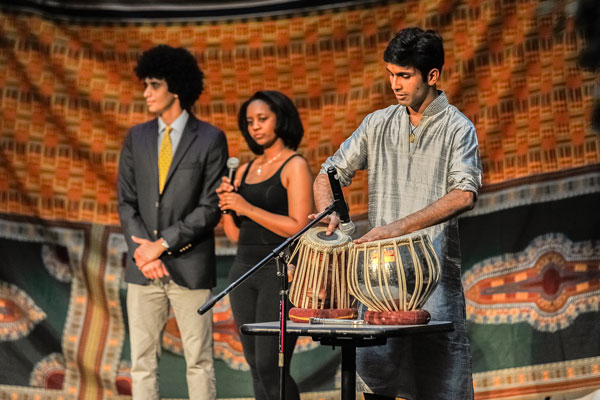
As co-director of the show, Cannon Society student Sloane Mebane had a vision for FABRIC that was inspired by her own Revisit experience in 2016, when she visited the HMS campus with a few doubts—and hopes.
Mebane was fairly certain she wanted to enroll at HMS, but coming from a historically black college, she said she was looking for the support she knew she would need to make the most of her medical school experience.
FABRIC helped show her there was a strong black student community at HMS and that it was supported by the School’s administration.
“It helped me see the School’s dedication to diversity and how supportive it would be to a student like me,” Mebane said.
Now, as co-director of FABRIC 2017, she is working to demonstrate the same welcoming atmosphere to other black students considering HMS.
“I think it’s important to show that we do believe in supporting diversity at the school and creating support systems so every student flourishes, and I think FABRIC is one way to show that dedication,” Mebane said.
Core strength
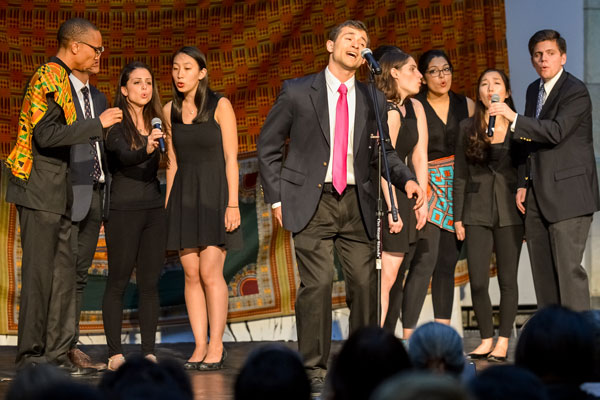
With a vision that FABRIC stay true to its original message, Mebane recruited acts that referenced the African diaspora. Performances ranged from an African-inspired dance to renditions of the traditional spirituals “Hold On” and “Wade in the Water.”
The spoken word also figured prominently this year, with three original poems by HMS students, including “Come, Kingdom, Come,” by Holmes Society student Timothy McGinnis and “The Paradox of Liberty,” by Castle Society student Jayne Rice.
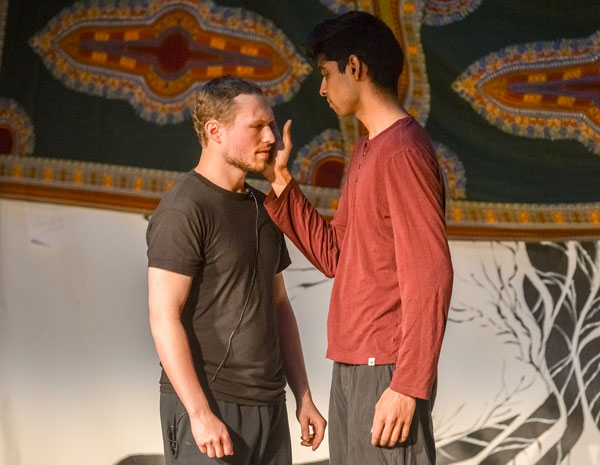
Influences from 20th- and 21st-century black Americans included a dramatic reading of James Baldwin’s “Giovanni’s Room,” and a reading of Ibrahim Sincere’s poem “By Any Means Necessary.”
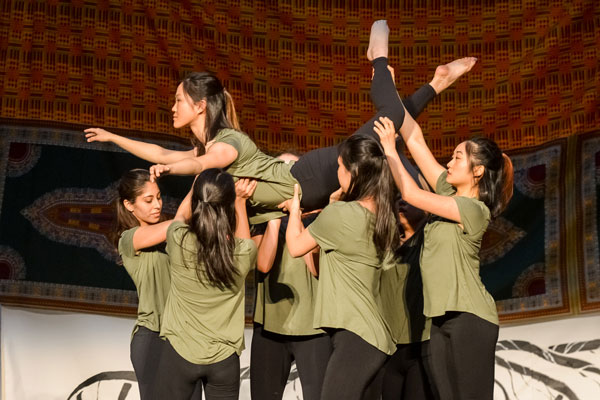
A lyrical dance choreographed by Amy Yu, Holmes Society, and Cara Lachtrupp, Cannon Society, performed to “Glory,” by rapper Common and singer John Legend, expressed a sentiment reminiscent of the civil rights movement that “One day, when the glory comes, it will be ours.”
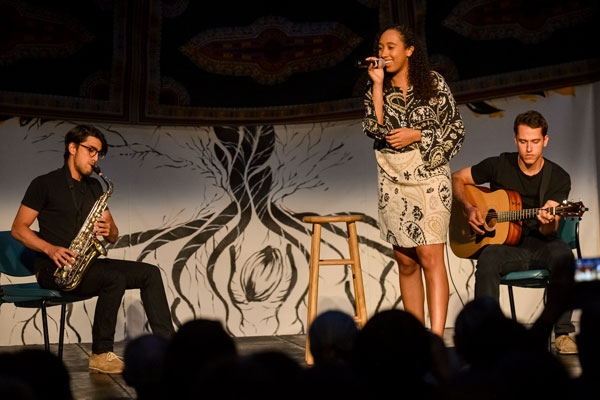
Other music from the black American experience included a dance set to hip-hop music and a performance of jazz artist Nina Simone’s classic song “Feeling Good,” sung by Holmes Society student Tiffany Minors, accompanied by Ryan Lisann on saxophone and Michael O’Donnell on guitar, both from Castle Society.
“We’re trying to display to students coming in, especially black students, that this is a space for them,” said Mebane about HMS and the show. “We really want the physician workforce to represent the population of this country.”

Those displays included the struggles voiced by three women—a Muslim, a Mexican and African American—who wrote and performed their poem “American Threat,” which expressed their anger about how their cultures are considered a threat to American society despite the discrimination and racism they experience in the U.S.
Honoring dedication to diversity
Each year at FABRIC the students recognize a faculty member and a staff member for their dedication to nurturing diversity at HMS and making all students feel at home.

Rhonda Bentley-Lewis, HMS assistant professor of medicine at Mass General, was recognized for her role as a mentor for black women at HMS and HSDM, and honored as the first African American woman to serve as chair of the Joint Committee on the Status of Women (JCSW) at HMS, which was established more than 40 years ago.

Several tributes were read as Carla Fujimoto, former assistant director of student affairs, was honored with the staff award. Fujimoto retired last month after 36 years at HMS and 21 years in student affairs.
“Carla’s way of supporting and encouraging all students put her in the rare category of providing unbiased equity in everything that she did,” read the tribute that Nancy Oriol, former dean for students, had written.
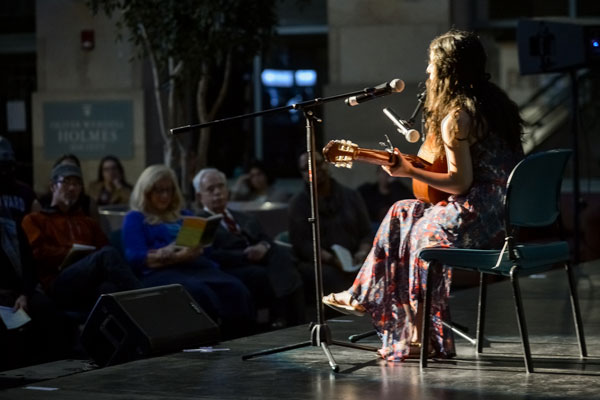
In an introspective moment, Holmes Society student Parisa Fallah took center stage and sang “We Are One,” by Dan Seals. The sentiments of the song expressed that it is through love and unity that we can overcome troubles in this world.
“One of our goals is to show the newly admitted students that there is a place for everyone at HMS,” said Lachtrupp, who was FABRIC 2017 co-producer.
Leafing Out

Heal the World
The FABRIC show strives to express the strength HMS and HSDM students find through their differences.
“Diversity is not just a check mark but is necessary to optimize learning and spark creativity,” said Ameen during the show’s introduction.
These future doctors at HMS are listening to one another’s struggles, accepting one another’s journeys, and drawing on one another’s strengths in order to bring compassionate care to the world.
View the related photo gallery.
All images by Steve Lipofsky for HMS.

